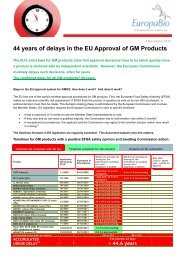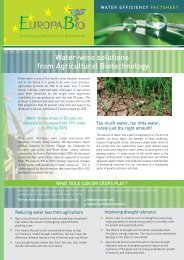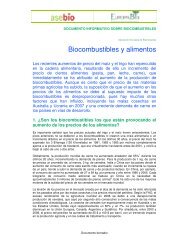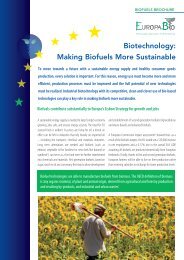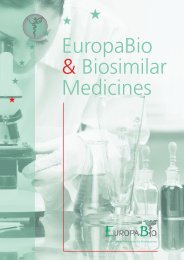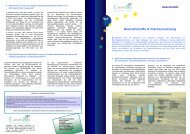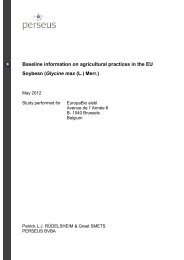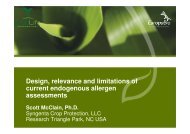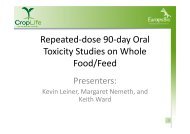GM crops: Reaping the benefits, but not in Europe - Europabio
GM crops: Reaping the benefits, but not in Europe - Europabio
GM crops: Reaping the benefits, but not in Europe - Europabio
You also want an ePaper? Increase the reach of your titles
YUMPU automatically turns print PDFs into web optimized ePapers that Google loves.
8<br />
4. GLOBAL IMPACTS ON THE ENVIRONMENT<br />
Less land use and better resource efficiency<br />
Increas<strong>in</strong>g yields by 6% - 30% on <strong>the</strong> same amount of land avoids <strong>the</strong> need to cultivate land that<br />
currently provides a haven for biodiversity or is used for conservation. <strong>GM</strong> <strong>crops</strong> with improved<br />
nitrogen-use efficiency need less fertiliser <strong>in</strong>put. Less spray<strong>in</strong>g and less need for fertiliser also means<br />
reductions <strong>in</strong> <strong>the</strong> use of tractor fuel and water. Soils are better protected from erosion and compaction<br />
through less plough<strong>in</strong>g, which helps conserve soil moisture. Field trials demonstrate that droughttolerant<br />
<strong>crops</strong> can yield up to 20% more than <strong>the</strong>ir non-<strong>GM</strong> counterparts under <strong>the</strong> same grow<strong>in</strong>g<br />
conditions, enabl<strong>in</strong>g farmers to grow more while us<strong>in</strong>g less water.<br />
Reduced CO 2 emissions<br />
Less tillage or plough<strong>in</strong>g also helps to reduce CO 2 emissions. In 2009, <strong>the</strong> comb<strong>in</strong>ed permanent and<br />
additional sav<strong>in</strong>gs through sequestration due to <strong>the</strong> cultivation of <strong>GM</strong> <strong>crops</strong> was equivalent to a sav<strong>in</strong>g<br />
of 17.6 billion kg of CO 2 or remov<strong>in</strong>g 7.8 million cars from <strong>the</strong> road for one year 17 . By enabl<strong>in</strong>g farmers<br />
to grow more food, more reliably, <strong>in</strong> less predictable and harsher climatic conditions, <strong>GM</strong> <strong>crops</strong> can<br />
also contri<strong>but</strong>e to climate change adaptation.<br />
Less use of plant protection products<br />
More efficient protection aga<strong>in</strong>st <strong>in</strong>sect damage results <strong>in</strong> a significant reduction <strong>in</strong> <strong>the</strong> need to<br />
spray <strong>crops</strong>. By 2009, <strong>the</strong> usage of <strong>GM</strong> <strong>crops</strong> had reduced pesticide spray<strong>in</strong>g by 393 million kg of<br />
active <strong>in</strong>gredients, <strong>the</strong> equivalent of decreas<strong>in</strong>g 17.1% of <strong>the</strong> global pesticide use 18 . There is a clear<br />
decrease <strong>in</strong> <strong>the</strong> amounts of plant protection products applied to <strong>GM</strong> <strong>crops</strong> 19 , <strong>in</strong>clud<strong>in</strong>g a substantial<br />
25-33% decrease <strong>in</strong> <strong>the</strong> use of agrochemicals for herbicide resistant <strong>crops</strong> 20 . While herbicide resistant<br />
weed populations may emerge, this is <strong>not</strong> a challenge specific to <strong>GM</strong> plants <strong>but</strong> applies equally for<br />
conventional agriculture. The adoption of herbicide tolerant plants led to a reduction <strong>in</strong> <strong>the</strong> toxicity of<br />
<strong>the</strong> herbicides used, and to a wider take up of no till farm<strong>in</strong>g, <strong>the</strong>reby limit<strong>in</strong>g soil erosion, fuel use and<br />
CO 2 emissions.<br />
Protect<strong>in</strong>g biodiversity<br />
Land use is probably <strong>the</strong> most important impact of agriculture on biodiversity. In general, biodiversity<br />
<strong>in</strong> fields is much lower than <strong>in</strong> untouched natural surround<strong>in</strong>gs. This is <strong>in</strong>herent to <strong>the</strong> purpose of<br />
grow<strong>in</strong>g a certa<strong>in</strong> type of crop and avoid<strong>in</strong>g <strong>the</strong> presence of too many o<strong>the</strong>r organisms, such as weeds<br />
and pests, on <strong>the</strong> same field. The high performance of <strong>GM</strong> <strong>crops</strong> allows for <strong>in</strong>tensive farm<strong>in</strong>g, mean<strong>in</strong>g<br />
less land needs to grow <strong>the</strong> same amount of <strong>crops</strong>. Biodiversity on and around fields is a question of<br />
agricultural practices, <strong>not</strong> of crop technology. Numerous studies have demonstrated that <strong>GM</strong> <strong>crops</strong><br />
have no adverse effects on non-target <strong>in</strong>sects 21 . The reduction <strong>in</strong> crop biodiversity is l<strong>in</strong>ked to crop<br />
improvements <strong>in</strong> general, and <strong>not</strong> specifically to <strong>GM</strong> technology.



